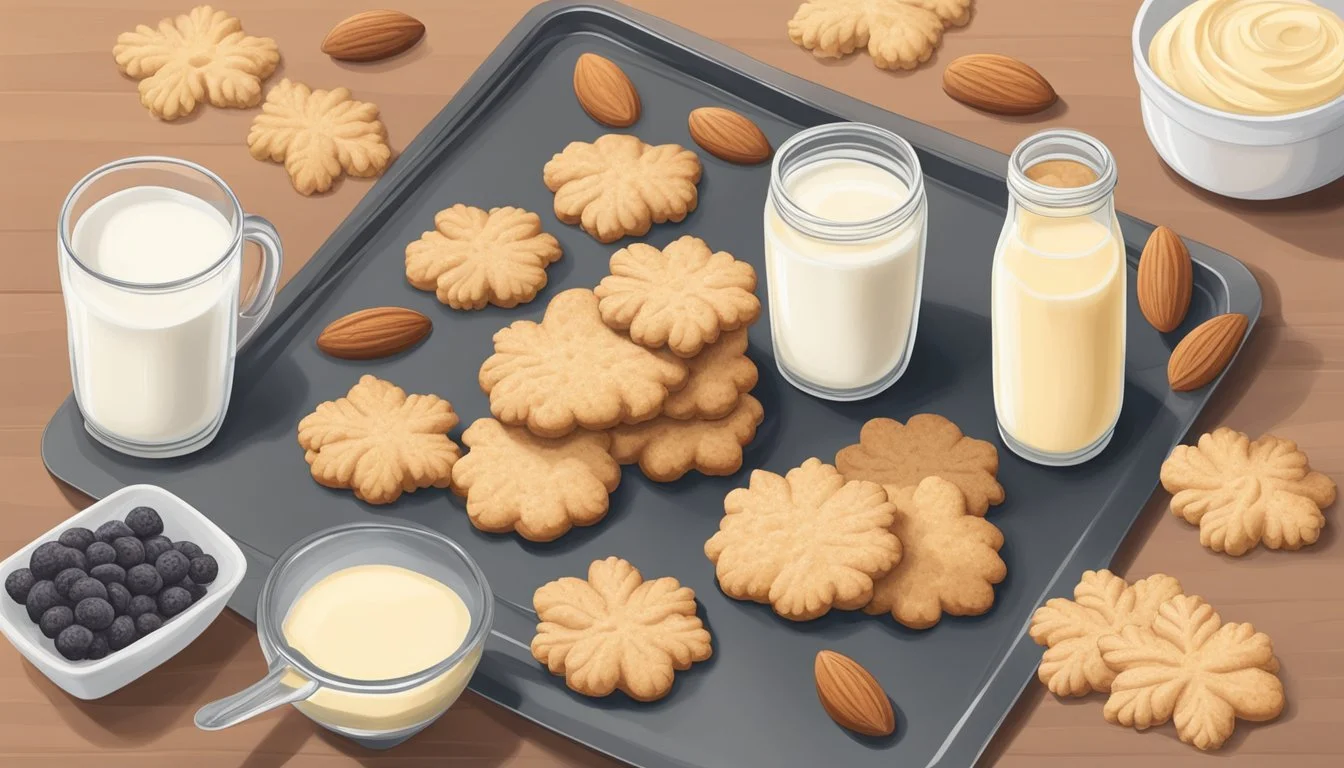Are Spritz Cookies Vegan?
Unveiling the Ingredients
Spritz cookies, traditionally a buttery and rich holiday treat, typically contain dairy and eggs, which are not vegan-friendly ingredients. The cookies are recognizable by their delicate, crispy texture and intricate shapes, usually created with a cookie press. However, with growing dietary preferences and the rise of plant-based lifestyles, vegan adaptations of spritz cookies have been developed, allowing those following a vegan diet to enjoy this classic treat.
Vegan spritz cookies substitute plant-based ingredients for the animal products commonly found in conventional recipes. Vegan butter and plant milk are used in place of dairy butter and milk, while alternatives like flax eggs can replace chicken eggs. This ensures the treats are free from animal-derived ingredients while aiming to replicate the light, airy texture that spritz cookies are known for.
Crafting vegan spritz cookies involves methods similar to the traditional recipe, such as creaming together the vegan butter and sugar until light and fluffy, before incorporating the other ingredients. To achieve the characteristic shape, the dough is then piped or pressed onto a baking sheet and baked until golden brown. These cookies can therefore provide a cruelty-free option for those looking to maintain holiday traditions or simply enjoy a vegan-friendly sweet snack.
Understanding Spritz Cookies
Spritz cookies are a beloved treat known for their delicate texture and festive shapes, often associated with holiday traditions and rich in history.
History and Tradition
Spritz cookies, originating from Germany and Scandinavia, are linked to Christmas festivities. These buttery cookies, which date back to the 16th century, are named after the German word "spritzen", meaning to squirt, which is exactly how these cookies are formed, using a cookie press to squirt the dough through patterned holes.
Basic Components of Spritz Cookies
The fundamental ingredients of spritz cookies are simple yet precise: sugar, flour, and butter serve as the base, providing the cookie with its characteristic flavor and crumbly texture. Often, vanilla extract or almond extract is added for flavoring. The balance of these ingredients ensures the cookies maintain their shape during baking and achieve the desired tender bite.
Significance of Cookie Press in Shaping
The cookie press is an essential tool for making spritz cookies, as it allows for the dough to be shaped into intricate designs with ease. By loading the dough into the press and pushing it through patterned disks, a variety of shapes such as wreaths, trees, or flowers can be created. This process is not just for aesthetics; it ensures consistent size and thickness of cookies for even baking.
Popular Spritz Cookie Flavors
While the classic spritz cookie has a buttery vanilla flavor, other popular variations include chocolate, citrus zest, or spices such as cardamom. During the holiday season, spritz cookies may be adorned with festive sprinkles, glazed with icing, or dipped in melted chocolate, enhancing their appeal and variety of flavors.
In summary, spritz cookies hold a special place in the realm of confections, marrying tradition with the simplicity of a few staple ingredients and the creativity allowed by the cookie press. Whether it's for a Christmas party or a family gathering, these cookies continue to be a cherished treat.
Exploring Veganism
In the context of baking, such as with spritz cookies, the key to crafting delicious vegan treats lies in understanding the essentials of veganism, recognizing suitable substitutes, and acknowledging the health and ethical motivations driving this dietary choice.
Definition of Veganism
Veganism is a dietary and lifestyle choice where individuals abstain from the use of animal products, particularly in diet, and extends to reject the commodity status of animals. A vegan diet is dairy-free, excludes meat, eggs, and animal-derived ingredients. This practice is often motivated by a variety of reasons, including but not limited to ethical concerns, environmental factors, and health considerations.
Common Vegan Substitutes
To adapt recipes such as spritz cookies to fit a vegan diet, various substitutes are employed.
Dairy Alternatives: For butter, vegan butter made from plant oils can be used. Plant-based milks, like almond, soy, oat, or coconut milk, stand in for cow's milk.
Egg Replacers: Ingredients like mashed banana, applesauce, chia seeds, or commercial egg replacer products can mimic the binding properties of eggs.
Other Substitutes: Vegan chocolate made without dairy is available for those who enjoy chocolate-flavored cookies.
Substitute Type Examples Vegan Butter Margarine, oil-based spreads Plant-Based Milk Almond, soy, oat, coconut milk Egg Replacer Commercial replacers, flaxseeds Vegan Chocolate Cocoa-based, dairy-free chocolate
Health and Ethical Considerations
The switch to a vegan diet often accompanies awareness regarding animal welfare and the environmental impact of animal agriculture. From a health perspective, vegan cookies typically contain less saturated fat, provided they are made with healthy oil alternatives. However, care must be taken to manage nutrition well, as vegan diets can lack certain nutrients found more readily in animal products. Calorie content of vegan products varies, and it is essential to focus on whole foods and nutrient density.
Creating Vegan Spritz Cookies
In the world of baking, the creation of vegan spritz cookies involves thoughtful selection of plant-based ingredients and adapting traditional baking techniques. These delightful cookies can be decorated in a myriad of ways and, with proper storage, can be enjoyed as fresh as the day they were baked.
Choosing the Right Ingredients
Success in crafting vegan spritz cookies hinges on using the right ingredients. The cornerstone is vegan butter, which should have a composition that allows for a light and fluffy texture when creamed with sugar—a crucial step in the recipe. For the cookie's structure, all-purpose flour is generally preferred for its consistent results. One should ensure that all ingredients, including sprinkles and icing used for decorating, are certified vegan to comply with dietary choices.
Vegan Baking Techniques
Baking vegan spritz cookies requires a modification of traditional methods to achieve the desired consistency and flavor. The technique of creaming together vegan butter and sugar until airy is essential for creating a delicate crumb. Most recipes recommend baking in a preheated oven for a precise duration to prevent over or under-baking, which can lead to suboptimal textures. The oven temperature and baking time need to be monitored closely, as vegan ingredients can behave differently than their non-vegan counterparts.
Decorating Vegan Cookies
Decorating is where bakers can express their creativity with vegan spritz cookies. Prior to baking, cookies can be topped with vegan sprinkles or colored sugars. After baking and cooling, they can be drizzled with vegan icing or dipped in vegan chocolate, taking care to use plant-based colors and decorations. The aesthetic touch should complement the flavor and texture of the cookies while adhering to the vegan theme.
Storing and Serving
Proper storage extends the enjoyment of vegan spritz cookies. Once fully cooled, cookies should be placed in an airtight container to maintain their crispness. They can be kept at room temperature for short-term enjoyment or freeze for long-term storage. Defrosting is best done in the container at room temperature to prevent moisture build-up. Serving the cookies fresh or at the ideal texture after thawing ensures the best tasting experience.
Recipe Guidance
In this section, readers will explore the nuances of making vegan spritz cookies, from the precision needed in the recipe to the flexibility of flavor adaptations.
Step-by-Step Vegan Spritz Cookie Recipe
To create the dough for vegan spritz cookies, one should start by creaming together vegan butter and sugar until the mixture is light and fluffy, a process that usually takes about two minutes. Then, incorporate vanilla extract for classic flavor. Next, blend in the dry ingredients, which typically consist of flour, baking powder, and a pinch of salt. Once combined, the dough should be of a consistency that can hold its shape when piped but is not too stiff to work with. For preparation, preheating the oven to 375° F (190° C) is a common directive, and a cook time of approximately 16 to 17 minutes will often achieve the desired golden hue.
Prep time: Generally around 15-20 minutes
Cook time: 16-17 minutes
Total time: 31-37 minutes (does not include cooling)
Assessing Texture and Taste
Vegan spritz cookies aim for a tender and buttery texture, similar to traditional versions that use dairy butter. The key is to find balance—too much creaming can lead to an overly airy cookie, while scant mixing can result in a denser bite. The taste should be rich, often with the butter flavor being a highlight complemented by the chosen extract—vanilla is a staple but is not the only option. One should assess the dough's readiness by its ability to be pressed or piped while maintaining its shape, indicating a good structure for crisp edges once baked.
Adjustments and Flavor Variations
Adapting the classic vegan spritz cookie recipe allows the baker to cater to diverse palates and occasions. Extracts offer a simple way to infuse variety, with options extending to orange, lemon, peppermint, or cinnamon — each providing its unique profile to the cookie. For a nutty twist, finely ground almonds or walnuts can be incorporated into the dough. And, if one desires a more pronounced citrus note, the zest of the fruit can be added. These variations should be made considering the original recipe's balance of wet and dry to maintain the desired texture.
Extracts: Vanilla, Orange, Lemon, Peppermint, Cinnamon
Nuts: Almonds, Walnuts
Citrus zest for enhanced flavor
Additional Tips and Tricks
Crafting the perfect vegan spritz cookie involves precision and creativity. Ensuring the dough's consistency is just right for piping and that the cookies retain their shape while baking are key considerations. With a focus on troubleshooting common issues, stylish presentation, and community engagement, this section offers valuable advice to enhance your vegan spritz cookie experience.
Troubleshooting Common Issues
To address dough consistency issues, one should ensure that ingredients are at room temperature before mixing. If the dough is too stiff to pipe, a small amount of plant milk can be gradually added to the large mixing bowl to achieve the desired pliability. Conversely, if the dough is too soft, chilling it briefly in the fridge can help. Using a hand mixer aids in achieving light and fluffy batter, crucial for the cookie's texture.
Presentation and Gifting Ideas
For presenting or gifting these holiday cookies, creativity sets one's cookies apart. Utilize a piping bag with star or flower tips to shape dough into Christmas trees, snowflakes, or other festive designs. Once baked and cooled, decorate with vegan-friendly dyes or sprinkles. When gifting, placing the cookies in a decorative tin or box lined with parchment paper enhances the appeal.
Engaging with Online Communities
Sharing one's vegan cookie creations and connecting with others can be done through platforms like Instagram and Pinterest. When posting, high-quality images and detailed captions that discuss the vegan recipe used or the types of decorations can invite conversation and tips exchange. Additionally, searching for and using specific hashtags like #VeganBaking or #HolidayCookies can increase the visibility of the posts within those online communities.





